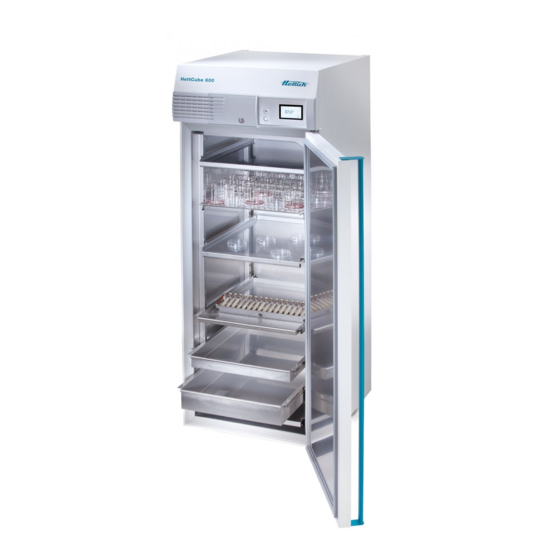
Summarization of Contents
1 Introduction
General Information and Symbols
Explains symbols, warnings, and shipping carton information for proper handling.
Safety, Personnel, and Usage Guidelines
Covers PPE, personnel qualification, and the intended use of the incubator.
Scope, Delivery, and Returns
Information on replacement parts, delivery scope, and procedures for returning the incubator.
3 Device description
Standard Device Features
Describes the core components and features of the standard HettCube incubator.
Available Options and Accessories
Details optional features like glass doors, access ports, switchboards, dehumidification, and accessories.
5 Commissioning
Unpacking and Initial Setup
Guides users through unpacking, installation, power connection, and initial incubator configuration.
Installing and Removing Modules
Procedures for installing and removing standard and telescopic slide-in modules and drawers.
6 Operation
6.1 Operating elements
Identifies and describes the main operating elements on the front of the incubator.
6.2 Loading
Provides guidelines on how to properly load samples into the incubator, considering load limits.
6.3 Door locking mechanism
Explains how to use the door locking mechanism to prevent unauthorized access to the incubator.
6.4 Fixing the mechanical display protection of the control panel
Details how to secure the control panel using mechanical display protection for added safety.
6.5 Standard check before every use
Lists essential checks to perform before each use to ensure the incubator is safe and ready.
6.6 Switching on the incubator
Instructions on how to power on the incubator and initiate the startup sequence.
6.7 Initialization
Refers to the initial commissioning process for setting up the incubator's parameters.
6.8 Operating modes
Explains the available operating modes (standstill, manual, program), main screen, and process flow monitoring.
6.9 Main screen
Describes the main screen interface and its operating concepts for navigation.
6.10 Process flow information
Explains how to view and interpret process flow information, including events and temperature curves.
6.11 Manual mode
Detailed guide on configuring and using manual mode, including settings, temperature drops, and protection.
6.12 Program mode
Comprehensive guide to program mode, covering creation, editing, management, and execution of temperature profiles.
6.13 Device settings
Central section for configuring device parameters like date/time, temperature, guards, connectivity, language, and system info.
6.14 Heat compensation
Explanation of how the incubator compensates for heat generated by internal devices.
7 Cleaning, disinfection and maintenance
Cleaning Procedures
Detailed instructions for cleaning the incubator's housing and interior surfaces.
Disinfection and Contaminant Removal
Procedures for disinfecting against infectious materials and removing radioactive contaminants.
Autoclaving and Maintenance Schedule
Guidelines for autoclaving parts and the recommended maintenance schedule for longevity.
8 Troubleshooting
Error Handling and Circuit Breakers
How to activate circuit breakers and interpret/resolve warnings and error messages.
Specific Error Scenarios and Alarms
Addresses specific issues like door warnings, event overviews, tolerance band alarms, and temperature protection.
9 Technical data
Model Specifications
Detailed technical specifications for HettCube 200, 200 R, 400, 400 R, 600, and 600 R models.
Dimensional and Usage Data
Information on utilized space, type plate details, and physical dimensions of the incubators.
13 Appendix
Software Symbols and Examples
Reference guide to software symbols and practical examples of incubator operation.

















Need help?
Do you have a question about the 62000 and is the answer not in the manual?
Questions and answers